HALLOWEEN CROSSED WITH HISTORY
Camden Fall Festival Glories in Ghosts, Graves and a Pinelands Devil
Also see: Fall Festival Photo Feature.
October 29, 2001
By Hoag Levins
CAMDEN, N.J. -- The lore of grotesque creatures, crypts of the rich and famous and high-tech ghost hunters drew some of the largest crowds in recent memory to the Camden County Historical Society's (CCHS) Fall Festival yesterday.
"This is one of the liveliest and best-attended events we've had in a long time," said CCHS Executive Director
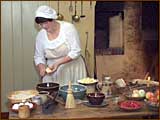
|
| Photo: Hoag Levins. |
|
Hazel Werner prepares the day's 18th-century meal in an open-hearth kitchen.
|
|
John Seitter as he jostled his way into a crowded 18th-century open-hearth kitchen where a cook in period garb prepared a ham dinner and all the fixings around a roaring wood fire.
'Halloween & History'
"We were hoping for a day that would be as entertaining as it was educational and I think we've hit the Halloween & History theme just right," said Seitter as he dutifully performed a taste test on the first pan of cranberry-apple crisp to come off the coals.
Meanwhile, in the second-floor auditorium of the adjoining library building, Jim Albertson, the day's first speaker, was invoking the spirit of the Jersey Devil, one of America's oldest monster legends.
Albertson is past president of the New Jersey Folklore Society and an advisory board member of the Down Jersey Folk Life Center at Wheaton Village in Millville. A widely recognized authority in southern New Jersey folklore, he has collected and recorded for the Smithsonian Institution the guitar- and dulcimer-based story-songs of southern New Jersey's "Piney" culture.
From the 18th century, the isolated communities
of "Pineys" -- farmers, loggers, hunters and watermen -- throughout the Pine Barrens were renowned for their sense of superstition and their vivid tales of witches, ghosts and pirates.
The Jersey Devil
The 58-year-old Albertson noted that their most famous legend is also widely known by the wrong name. "Only outsiders refer to him as the 'Jersey Devil,'" he said. "Pineys have always called him by his family name, the 'Leeds Devil.'"
With the flair and drama of a veteran stage performer, Albertson made the Leeds Devil real for a rapt audience that included a substantial number of wide-eyed children.
The program focused first on the scary legend and then on the historical roots from which such fantastic stories arise.
Grotesque creature
The general description of the Leeds Devil that has circulated since the early eighteenth century is that of a creature about three-feet high with a large, horse-like head with horns out the side. He is said to have a goat-like lower body with cloven hooves, claws on his fingers and large, angular, leathery wings like those of a huge bat. Much of his body is covered in matted black fur.
The legend says the grotesque being was born to a human mother -- Deborah Leeds -- who cursed her 13th pregnancy and wished for the devil to relieve her of the burden of another child.
Mother Leeds lived on a small farm in Leeds Point, an area of woodlands and swamp fringing the western shore of Barnegat Bay in Atlantic County.
"Salem, Massachusetts wasn't the only place where women were accused of witchcraft back then," Albertson explained. "In New Jersey and elsewhere in the colonies along the eastern seaboard it was common for a woman to be accused of being a witch if she gave birth to a severely deformed child."
Locked-away child escaped
He said Mother Leeds is believed to have given birth to such a child and then imprisoned the horribly misshapen youngster in her farmhouse so neighbors would never see him. But at some point the child escaped and wandered the surrounding area, where locals spotted and described him as a woodlands monster or devil.
Tales of a hellish creature roaming the Pinelands were passed from generation to generation with constant embellishment, Albertson said. Then the legend received a strong boost in modern times as a result of widespread "sightings" of the Leeds or Jersey Devil early in the twentieth century.
"In 1909," said Albertson, "there was a panic in New Jersey as hundreds of normal, respectable citizens reported sightings of what they said was the Jersey Devil. The reports had the Jersey Devil landing in backyards, on the tops of trolley cars, on barn roofs and the like. And many people described how the creature would spread its big wings and let out a blood-curdling scream."
Birds mistaken for devils
"But," he continued, "there was also an unusual and very heavy migration of sandhill cranes through southern New Jersey that year." Sandhill cranes stand about 36 inches high, have six-foot wingspans and a peculiarly sharp cry.
As the cranes swooped down throughout the woods and swamps and fields where they had not been seen before, residents often viewed them through morning mists, evening fogs and the murky shadows of ill-lit streets -- and saw winged devils instead of birds, Albertson said.
Touring Historic Harleigh
In mid-afternoon, a bus provided to the Historical Society by the County Board of Freeholders, ferried visitors the short distance to Harleigh Cemetery's
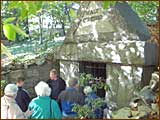
|
| Photo: Hoag Levins. |
|
Visiting Walt Whitman's tomb.
|
|
main gates for a tour of the 116-year-old facility.
Sprawling for 150 acres along Cooper River on the eastern border of Camden, Harleigh is one of the country's most historically significant cemeteries. A pioneer of the Victorian-era concept of cemeteries as lush public parklands, it is also a picturesque "city of the dead" where affluent families expressed their social status with ornate memorial architecture.
'Who's Who of cemeteries'
"This is the Who's Who of cemeteries for the business luminaries and artists of Camden County," said Chris Mojica, manager of Harleigh and the day's tour guide. Outfitted in a black cowboy hat and black leather coat, he led a long line of visitors up and down the winding paths that traverse the park's heavily wooded hills and marble grottos.
Mojica, whose family has a long history in the funerary trade, motioned through the trees to the birds pecking around the shores of one of the cemetery's three man-made lakes. "This place is also a nature preserve," he said. "At last count, there were something like 124 species of birds sighted here throughout the year."
He noted that the manager of Harleigh has to be comfortable with tourist visitors because the facility's most famous tomb -- Walt Whitman's -- has been drawing an endless stream of them for the last century. Gathering the tour group around Whitman's mausoleum in the side of sun-dappled hill, he said the famed poet selected the spot and designed the tomb himself.
Dead poet as marketing device
"When Harleigh was established in 1885," Mojica explained, "the owners
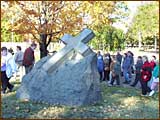
|
| Photo: Hoag Levins. |
|
The tour passes one of the huge and unique grave markers scattered across Harleigh.
|
|
offered Walt Whitman free burial ground. He was one of the most famous people around and they knew if he was buried here it would attract other famous people. Whitman designed his tomb to resemble the walls of King Solomon's temple and had it assembled like an ancient temple with no rods, bolts or screws. It's just ten-ton pieces of granite put together with gravity as glue."
The one-ton granite door of the mausoleum remains permanently open at Whitman's request. "He said he wanted it that way so his soul could roam free," Mojica said.
Podium-shaped gravestone
After moving part of the crowd out onto an overlook, Mojica pointed across a lake to the far shore where a grave is marked by a marble podium. "We have other well-known poets here," he said. "That podium is the grave of Nick Virgilio, the renowned Haiku poet. He died in 1989 and every year an association from Rutgers University comes here to celebrate his birthday. They bring wine and cheese and cake and toast the man as well as the art."
"In a lot of ways," said Mojica, "because so many people come here to be near spirits that matter to them, this place is more about life and beauty than it is about death."
High-Tech Ghost Chasers
Ghost chasing was the final topic at Fall Festival day as South Jersey Ghost Researchers
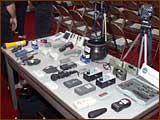
|
| Photo: Hoag Levins. |
|
A display of the electronic equipment used by South Jersey Ghost Researchers.
|
|
(SJGR) turned the CCHS auditorium into a display room of high-tech equipment and evidence from their investigations.
Billing itself as "The Delaware Valley's Oldest Ghost Research Group," SJGR provides free services to people who believe their buildings are haunted. Along with private homes, the group has conducted investigations at a number of historic sites including Fort Mott in Salem, Eastern State Penitentiary in Philadelphia, and the Gabreil Davies Tavern in Glendora.
Profiled on MSNBC
They opened their presentation with a video clip of an MSNBC feature detailing their recent search for ghostly activity in the Burlington County Jail Museum in Mount Holly. The program quoted skeptics who questioned the validity of such work.
Paranormal investigator Dr. Andrew Nichols told MSNBC that "people want to believe in ghosts and so (have) a powerful psychological predisposition to have these types of experiences which may or may not have any type of genuine external component."
As the MSNBC clip ended, SJGR's Susan Bove noted that although Dr. Nichols was well respected, she disagreed with his assessment. "These (ghosts) are not conjured up by our sheer wish that they are there," she told
the auditorium crowd. "We have multiple examples of (ghost) voices that we get. We get pictures (of ghosts) all the time. And, when I'm standing in somebody's dark basement in northeast Philadelphia and I get a hand on my shoulder, I can guarantee I did not wish that upon myself."
Ghostly 'orbs'
In an area of the Burlington County Jail that once served as death row, the researchers said they found evidence of otherworldly things. As they do in most of their projects, they took photos that show small, circular spots of light. They call these "orbs" and say they are evidence of a ghostly presence. SJGR display boards set up around the auditorium were filled with orb-speckled photos of various building spaces.
"The theory is that orbs involve an energy transfer from the spirit to other nearby energy sources," said SJGR co-director Dave Juliano. "It could be heat energy in the air -- people report electrical appliances or light bulbs blowing out (in haunted houses) a lot. It could be spirits are throwing energy at that. We believe cameras capture
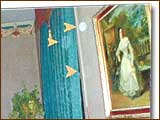
|
| Photo: Hoag Levins. |
|
An SJGR photo uses yellow arrows to point out "orbs."
|
|
this in orb form because energy transfers in mid-air, in keeping with the laws of physics, would normally manifest in a ball-like way. The orbs are semi-transparent and fall between infrared light and the normal spectrum of light our eyes can see. But they are recorded by still cameras and video cameras."
Voices of the dead
Bove ended the presentation by playing a series of digital computer files that contained mechanical-sounding voices of the dead the researchers say can't be heard by the human ear but were recorded by regular tape recorders in haunted houses.
"Keep in mind that video tape and audio tape is just film with oxidized material on it that captures and holds sounds and visual images," said Juliano. "A building can do the same thing when there is enough human emotion involved."
He explained that sometimes hauntings in old buildings may not actually involve present-day spirits but rather 'imprints' of past events. In effect, he suggested, houses can act as large recording devices that somehow capture and hold human activities and then, decades or even centuries later, 'replay' those ethereal sights and sounds to modern-day visitors.
| 






